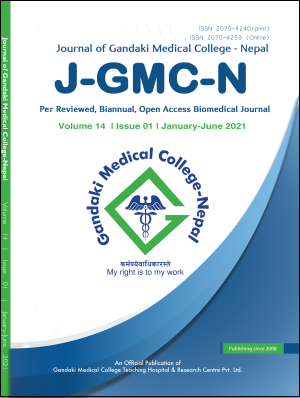Epidemiology and visual outcome of severe eye injuries in a tertiary center of Gandaki Province of Nepal
DOI:
https://doi.org/10.3126/jgmcn.v14i1.30936Keywords:
visual outcome, epidemiology, severe ocular traumaAbstract
Introduction: Ocular trauma is an important worldwide preventable public health problem which may lead to permanent visual impairment. This study aims to determine the demographics, clinical profile and visual outcome of severe eye injuries.
Methods: This study was conducted at a tertiary centre from January 2013 to August 2014. Cases of severe eye injuries hospitalized at or presenting to emergency/OPD were included in the study. All cases underwent detailed examination and necessary intervention. Cases were followed upto 3 months and final visual outcome was evaluated.
Results: The study comprised of 60 individuals (65 eyes); 76.7% males and 23.3% females. Out of 60 cases, the age group 1-9 years had the highest occurrence with 23.33% followed by 20-29 years with 20% and majority were students 45%. Impact with stone was the commonest cause of injury reported on 21.7% followed by road traffic accident (RTA) 20%. Closed-globe injuries accounted for 36.6% and open-globe injuries for 33.3%. At the time of presentation, visual acuity of less than 6/18 was seen in 71.6% and at follow up was seen in 45%. Among total cases, 63.3% eyes were managed conservatively, 30% eyes underwent surgery and 6.7% were referred to higher centre for vitreoretinal surgeries.
Conclusions: Severe eye injuries were seen in 0.13% of total eye injuries. Paediatric and young adult males formed the majority of victims. Stone and road traffic accidents were the common causes. One fourth of the eyes were blind. Primary prevention and management of the affected cases is the clear need.
Downloads
Downloads
Published
How to Cite
Issue
Section
License
This license allows reusers to distribute, remix, adapt, and build upon the material in any medium or format for noncommercial purposes only, and only so long as attribution is given to the creator.




